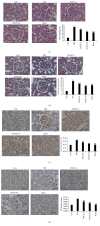Herba Artemisiae Capillaris Extract Prevents the Development of Streptozotocin-Induced Diabetic Nephropathy of Rat
- PMID: 29636780
- PMCID: PMC5832121
- DOI: 10.1155/2018/5180165
Herba Artemisiae Capillaris Extract Prevents the Development of Streptozotocin-Induced Diabetic Nephropathy of Rat
Abstract
Diabetic nephropathy (DN) is a major cause of end-stage renal disease throughout the world; until now there is no specific drug available. In this work, we use herba artemisiae capillaris extract (HACE) to alleviate renal fibrosis characterized by the excessive accumulation of extracellular matrix (ECM) in rats, aiming to investigate the protective effect of the HACE on DN. We found that the intragastric treatment of high-dose HACE could reverse the effect of streptozotocin not only to decrease the level of blood glucose and blood lipid in different degree but also further to improve renal functions. It is worth mentioning that the effect of HACE treatment was comparable to the positive drug benazepril. Moreover, we found that HACE treatment could on one hand inhibit oxidative stress in DN rats through regulating enzymatic activity for scavenging reactive oxygen species and on the other hand increase the ECM degradation through regulating the activity of metalloproteinase-2 (MMP-2) and the expression of tissue transglutaminase (tTG), which explained why HACE treatment inhibited ECM accumulation. On the basis of above experimental results, we conclude that HACE prevents DN development in a streptozotocin-induced DN rat model, and HACE is a promising candidate to cure DN in clinic.
Figures







References
LinkOut - more resources
Full Text Sources
Other Literature Sources
Miscellaneous

